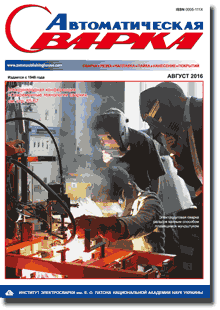| 2016 №08 (04) |
DOI of Article 10.15407/as2016.08.05 |
2016 №08 (06) |

Avtomaticheskaya Svarka (Automatic Welding), #8, 2016, pp. 29-34
Peculiarities of development of structural heterogeneity in the fusion zone of pearlite steel with austenitic nitrogen-containing weld metal
V.P. Elagin, V.N. Lipodaev And G.N. Gordan
E.O. Paton Electric Welding Institute, NASU, 11 Kazimir Malevich Str., 03680, Kiev, Ukraine. E-mail: office@paton.kiev.ua
Abstract
The peculiar features of development of structural heterogeneity at high-temperature heating in the unstable fusion zone of the austenitic weld with the pearlite steel were considered. It was shown that one of the factors influencing the high nickel content in the weld and low heat input of welding on reduction of width of ferrite interlayer is the decrease in overheating and degradation of carbides in the HAZ metal. However, these changes do not prevent the film precipitation of carbides and embrittlement of metal between the fusion zone and the HAZ. The alloying of austenitic weld metal with nitrogen, formation of nitride particles being more stable than the carbides, and refining the grains facilitate the increase in stability of structure, inhibition of carbide reactions and more uniform distribution of carbides in the fusion zone with pearlite steel, which improves the properties of welded joints of dissimilar steels. 14 Ref., 7 Figures.
Keywords: arc welding, welded joints of dissimilar steels, fusion zone, structural heterogeneity, diffusion of carbon, austenitic weld, nickel, nitrogen, decarburized zone, carburized zone, heat affected zone
Received: 15.05.16
Published: 03.10.16
References
- Gotalsky, Yu.N. (1981) Welding of dissimilar steels. Kiev: Tekhnika.
- Zemzin, V.N. (1966) Welded joints of dissimilar steels. Moscow: Mashinostroenie.
- Livshits, L.S., Khakimov, A.N. (1989) Metals science of welding and heat treatment of welded joints. 2nd Moscow: Mashinostroenie.
- Kirilichev, N.V., Gotalsky, Yu.N. (1980) Peculiarity of structural heterogeneity in fusion zone of multilayer austenitic weld with pearlitic steel. Svarka, 9, 28–32.
- Safonov, A.N., Radchenko, R.D., Chobanyan, V.A. (1993) Investigation of structural transformations in surface layers of low-alloy steel welded joints after laser treatment and subsequent heating. Proizvodstvo, 1, 4–7.
- Lipodaev, V.N., Snisar, V.V., Belchuk, M.V. et al. (1991) Specifics of brittle fracture of dissimilar welded joint with high-nickel weld metal. Svarka, 10, 6–9.
- Snisar, V.V., Lipodaev, V.N., Elagin, V.P. et al. (1991) Effect of nitrogen alloying of austenitic weld on development of structural heterogeneity in fusion zone with pearlitic steel. Ibid., 2, 10–14.
- Krishtal, M.A. (1972) Diffusion mechanism in iron alloys. Moscow: Metallurgiya.
- Minkevich, A.K. (1968) Chemical heat treatment. Moscow: Mashinostroenie.
- Lakhtin, Yu.M., Arzamasov, B.N. (1985) Chemical heat treatment of metals: Manual for institutes of higher education. Moscow: Metallurgiya.
- Zhitnikov, N.P., Zaks, I.A. (1971) Effect of nitrogen on structure of austenitic weld metal. Proizvodstvo, 8, 5–9.
- Elagin, V.P., Snisar, V.V., Lipodaev, V.N. et al. (1995) Mechanized welding of 15Kh5M steel without heating and heat treatment. Svarka, 8, 19–23.
- Makarov, E.L. (1981) Cold cracks in welding of alloy steels. Moscow: Mashinostroenie.
- Bojkova, K.I., Chizhik, A.I., Zemzin, V.N. (1975) Method of evaluation of susceptibility to brittle fracture of welded joints on criteria of fracture mechanics. Svarka, 2, 14.
